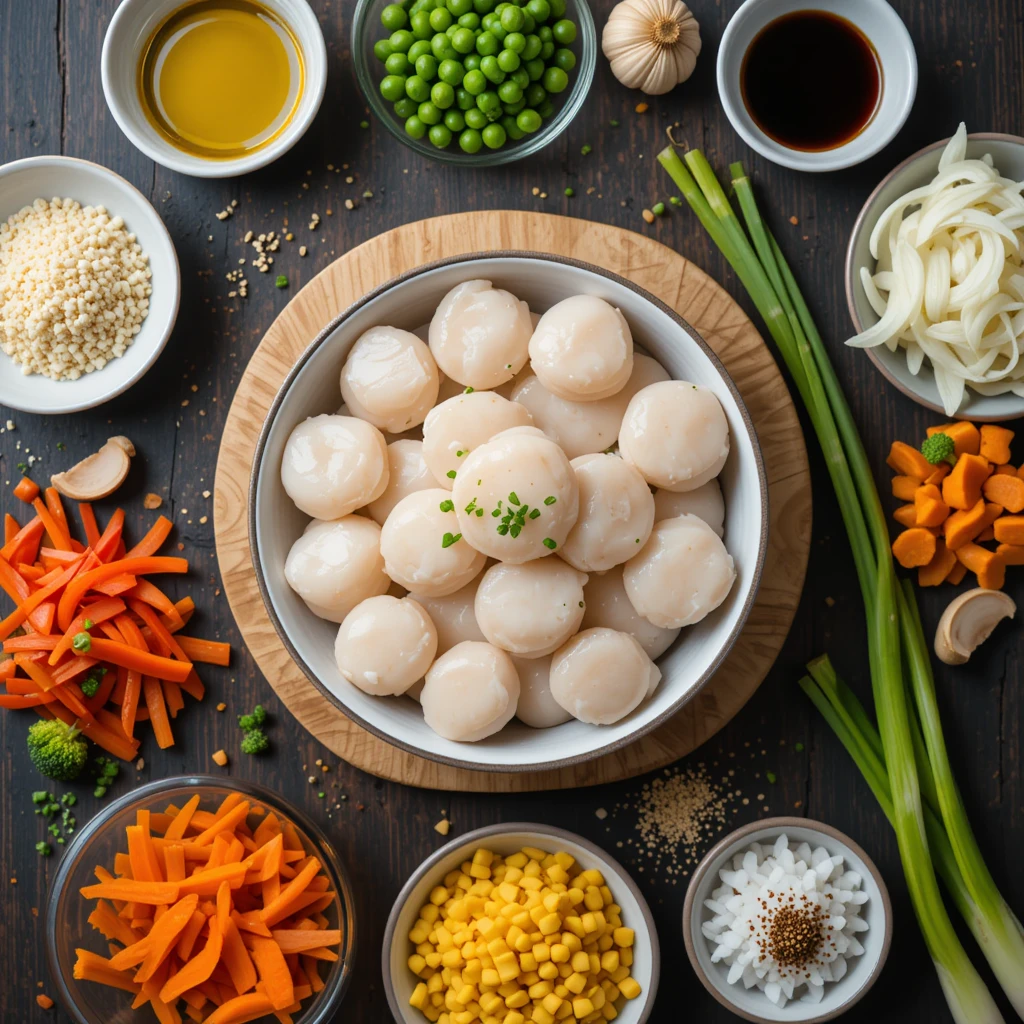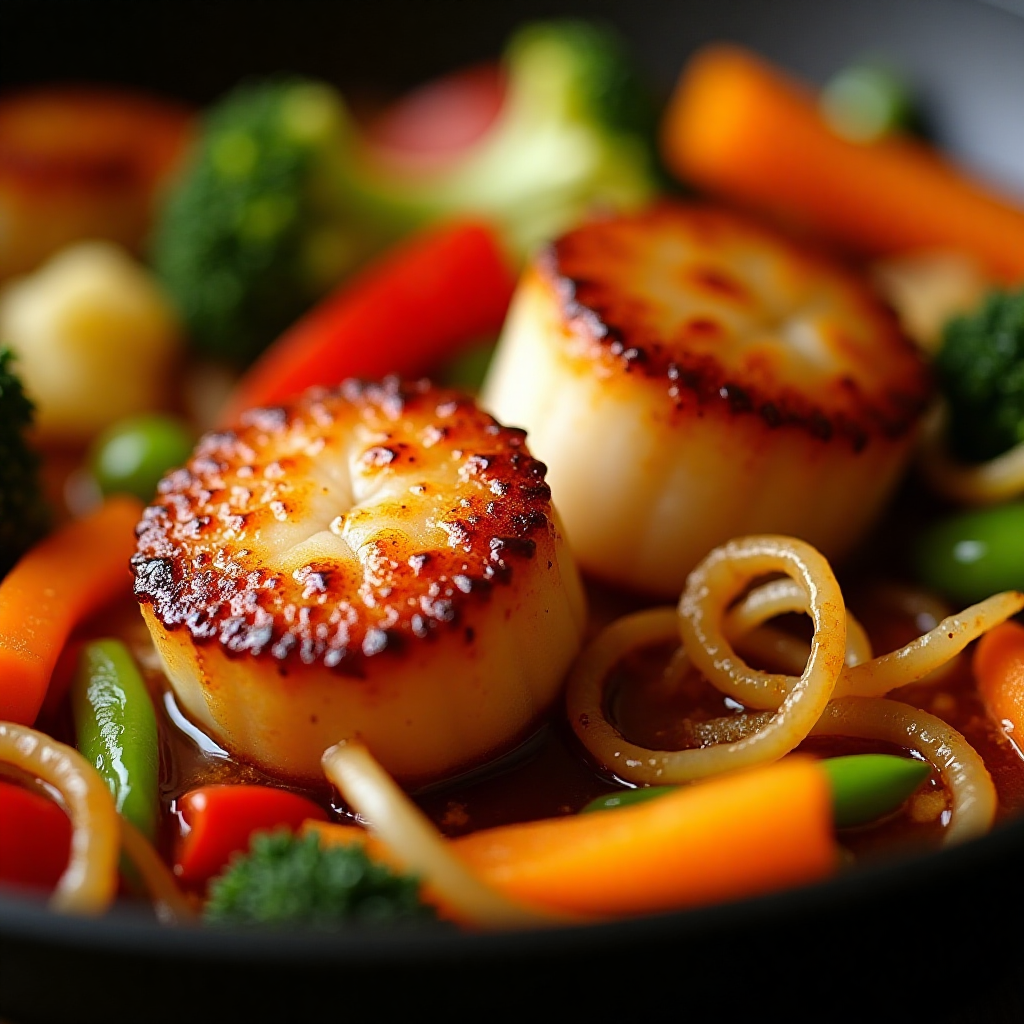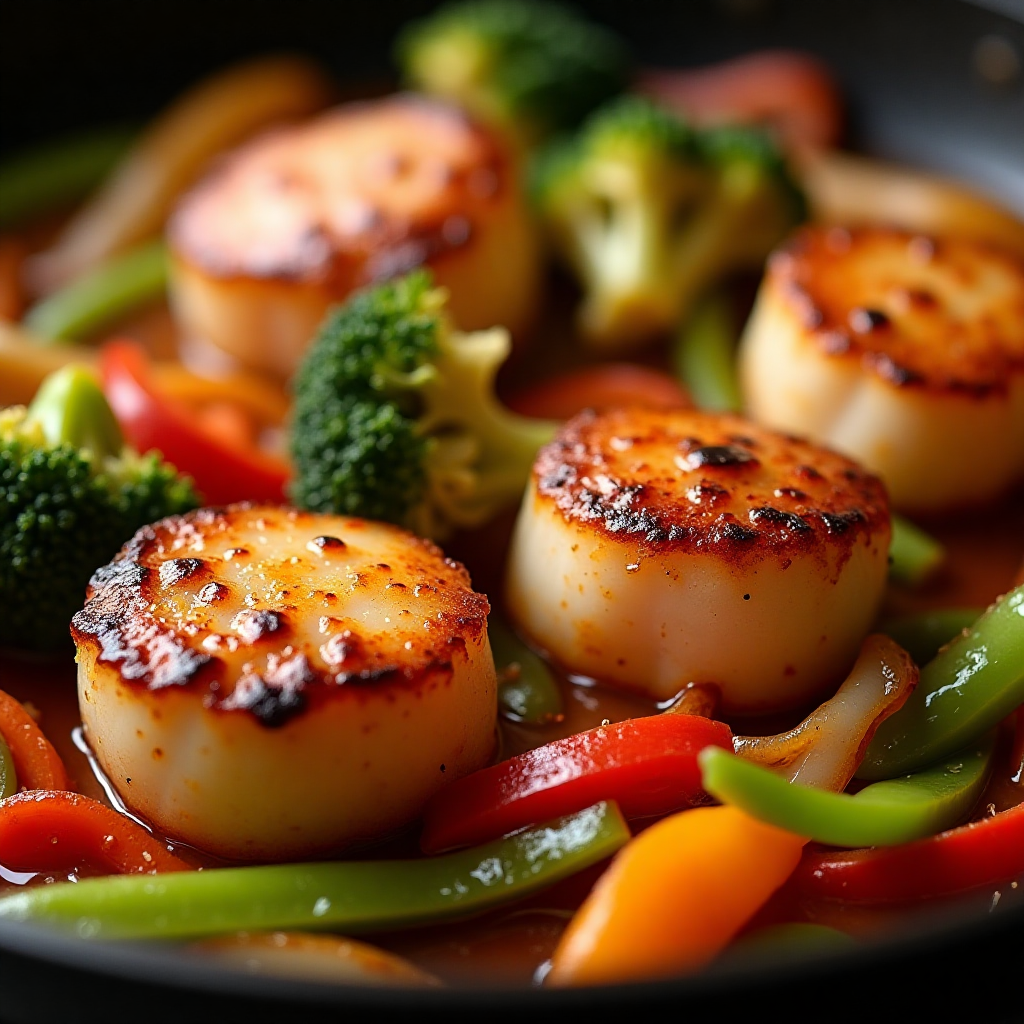Easy Scallop Stir Fry – 15-Minute Recipe for Perfect Results
Picture this: it’s 6 PM, you’re tired from work, and you need dinner on the table fast. Sound familiar? That’s where this amazing scallop stir fry comes to the rescue! This simple recipe turns ordinary weeknight cooking into something special. You’ll get tender, perfectly seared scallops mixed with crisp vegetables in just 15 minutes.
This scallop stir fry recipe is your answer to quick, healthy, and restaurant-quality meals at home. You’ll learn exactly how to cook scallops without making them rubbery, which vegetables work best, and the secret to that perfect golden sear. Best of all, this entire dish comes together in less time than it takes to order takeout!
Table of Contents
Why Scallop Stir Fry is Perfect for Busy Weeknights
When you’re short on time but don’t want to sacrifice flavor, scallop stir fry becomes your best friend. The entire cooking process takes just 15 minutes from start to finish. That’s faster than most frozen dinners and infinitely more delicious!
Scallops are nutritional powerhouses packed with protein, vitamin B12, and omega-3 fatty acids. A single serving gives you about 20 grams of lean protein with very few calories. This makes your scallop stir fry both satisfying and healthy.
The beauty of stir fry cooking lies in its flexibility. You can use whatever vegetables are in your fridge or swap seasonings based on your mood. Tonight you might go Asian-style with soy sauce and ginger. Tomorrow, try Mediterranean flavors with garlic and herbs.
Compared to ordering from your favorite seafood restaurant, making scallop stir fry at home saves you serious money. Restaurant scallop dishes often cost $25-30, while you can make this recipe for under $10 per serving.
Essential Ingredients for Scallop Stir Fry
Fresh Scallops Selection
The key to amazing scallop stir fry starts with choosing the right scallops. Look for scallops that smell like the ocean – fresh and clean, never fishy. They should be firm to the touch and have a slightly translucent appearance.
Understanding the difference between wet and dry scallops will change your cooking game. Wet scallops are treated with chemicals to preserve them longer, but they won’t sear properly. Dry scallops are untreated and will give you that beautiful golden crust we’re after. Always ask your fishmonger for dry scallops.
| Scallop Type | Treatment | Searing Ability | Best For |
|---|---|---|---|
| Dry Scallops | No chemicals | Excellent golden sear | Stir fry, pan searing |
| Wet Scallops | Chemical preservatives | Poor searing | Soups, stews |

Scallop Selection Checklist:
- Fresh ocean smell (never fishy)
- Firm texture when touched
- Slightly translucent appearance
- No strong chemical odor
- Dry to the touch
Store your scallops in the coldest part of your refrigerator and use them within two days. Before cooking, pat them completely dry with paper towels and remove the side muscle if it’s still attached.
Vegetables and Aromatics
The best vegetables for scallop stir fry are ones that cook quickly and add color and crunch. Bell peppers, snap peas, broccoli, and carrots are perfect choices. They hold their shape and don’t get mushy during the fast cooking process.
Quick-Cooking Vegetables for Stir Fry:
- Bell peppers (red, yellow, orange)
- Snap peas or snow peas
- Broccoli florets
- Carrots (julienned)
- Zucchini slices
- Mushrooms (shiitake or button)
- Baby corn
- Water chestnuts
Your flavor foundation starts with the holy trinity of stir fry: garlic, ginger, and onions. Fresh garlic and ginger make a huge difference compared to the powdered versions. Green onions add a mild bite and beautiful color to finish your dish.
Essential Aromatics:
- Fresh garlic (3-4 cloves, minced)
- Fresh ginger (1-inch piece, grated)
- Yellow or white onion (1 medium, sliced)
- Green onions (for garnish)
Seasonal Vegetable Substitutions:
- Spring: Asparagus, peas, baby spinach
- Summer: Zucchini, cherry tomatoes, corn
- Fall: Brussels sprouts, butternut squash
- Winter: Cauliflower, cabbage, root vegetables
Sauce Components
Your scallop stir fry sauce is where the magic happens. Start with a good quality soy sauce as your base. Low-sodium versions give you better control over the salt level. Add a splash of rice wine or dry sherry for depth.
For cooking, choose oils with high smoke points like vegetable oil, canola oil, or peanut oil. These won’t burn at the high temperatures needed for proper stir frying. Sesame oil is perfect for finishing but shouldn’t be used for cooking.
Optional flavor boosters include oyster sauce for richness, a pinch of red pepper flakes for heat, or a squeeze of fresh lime juice for brightness.

Kitchen Tools and Equipment Needed
The right equipment makes your scallop stir fry cooking much easier. A large skillet or wok works best because you need plenty of surface area. Cast iron or carbon steel pans hold heat well and create excellent searing.
| Equipment | Why It’s Important | Alternative Options |
|---|---|---|
| Large Skillet/Wok | Provides surface area, maintains high heat | Large non-stick pan |
| Sharp Knife | Quick, even vegetable prep | Mandoline slicer |
| Cutting Board | Safe prep surface | Large plate |
| Tongs | Safe scallop handling | Spatula |
| Small Bowls | Organization (mise en place) | Plates or cups |
Essential Tool Checklist:
- Large skillet or wok (12-inch minimum)
- Sharp chef’s knife
- Sturdy cutting board
- Tongs or spatula
- Wooden spoon or wok spatula
- Small prep bowls
- Measuring spoons
- Paper towels
Nice-to-Have Tools:
- Digital timer
- Microplane grater (for ginger)
- Kitchen scale
- Splatter screen
- Instant-read thermometer
Prep tools that save time include a good cutting board, measuring spoons, and small bowls for organizing your ingredients. Professional chefs call this “mise en place” – having everything in its place before cooking begins.
Step-by-Step Scallop Stir Fry Recipe
Preparation Phase (5 minutes)
Start by removing your scallops from the refrigerator and patting them completely dry. This step is crucial for getting that perfect golden sear. Remove any side muscles and season both sides lightly with salt and pepper.
Scallop Prep Steps:
- Remove scallops from refrigerator 10 minutes before cooking
- Pat completely dry with paper towels
- Remove side muscle if attached
- Season both sides with salt and pepper
- Let rest while preparing vegetables
Vegetable Prep Guide:
| Vegetable | Cutting Method | Size Guide |
|---|---|---|
| Bell Peppers | Strips | 1/4-inch wide |
| Broccoli | Florets | Bite-sized pieces |
| Carrots | Julienne | Matchstick size |
| Onions | Sliced | 1/4-inch thick |
| Snap Peas | Whole or halved | Remove strings |
Cut your vegetables into similar-sized pieces so they cook evenly. Slice bell peppers into strips, cut broccoli into small florets, and julienne your carrots. Everything should be bite-sized and ready to go.
Simple Stir Fry Sauce Recipe:
- 3 tablespoons soy sauce
- 1 tablespoon rice wine or dry sherry
- 1 teaspoon sesame oil
- 1/2 teaspoon cornstarch (optional, for thickening)
- Pinch of red pepper flakes (optional)
Mix your sauce in a small bowl combining soy sauce, rice wine, and any other flavor additions. Having your sauce pre-mixed prevents overcooking while you’re measuring ingredients during the cooking process.

Cooking Process (10 minutes)
Step-by-Step Cooking Instructions:
- Heat the Pan (1 minute)
- Heat pan over medium-high heat until hot
- Add 1 tablespoon cooking oil
- Oil should shimmer but not smoke
- Sear the Scallops (4-5 minutes)
- Place scallops in pan without crowding
- Don’t move for 2-3 minutes (listen for sizzling)
- Flip once and cook 1-2 minutes more
- Remove to plate and set aside
- Cook Hard Vegetables (2 minutes)
- Add carrots and broccoli first
- Stir constantly to prevent burning
- Vegetables should be crisp-tender
- Add Soft Vegetables (1 minute)
- Add bell peppers and snap peas
- Continue stirring
- All vegetables should be bright and crisp
- Finish the Dish (1-2 minutes)
- Return scallops to pan
- Add prepared sauce
- Toss gently for 30 seconds
- Remove from heat immediately
Temperature and Timing Guide:
| Cooking Stage | Temperature | Time | Visual Cues |
|---|---|---|---|
| Pan Heating | Medium-High | 1 min | Oil shimmers |
| Scallop Searing | Medium-High | 2-3 min/side | Golden crust forms |
| Hard Vegetables | Medium-High | 2 min | Bright colors, crisp-tender |
| Soft Vegetables | Medium-High | 1 min | Heated through |
| Final Toss | Medium-High | 30 sec | Sauce coats everything |
Pro Tips for Perfect Scallop Stir Fry Results
Temperature Control Secrets:
- Your pan should be hot enough that water droplets dance and evaporate immediately
- Too low: food steams instead of sears
- Too high: everything burns before cooking through
- Perfect temperature: oil shimmers but doesn’t smoke
The Golden Rules of Stir Frying:
- Never Overcrowd – Cook in batches if necessary
- Keep Moving – Constant motion prevents burning
- High Heat, Fast Cooking – Quick searing locks in flavors
- Prep Everything First – No time to chop during cooking
- Sauce Goes Last – Add at the very end to prevent burning
Perfect Scallop Sear Indicators:
- Sizzling sound when scallops hit the pan
- Golden-brown crust forms (don’t peek too early!)
- Scallops release easily when ready to flip
- Internal temperature reaches 120°F (medium-rare)
Texture and Doneness Guide:
| Doneness Level | Internal Temp | Texture | Visual Cues |
|---|---|---|---|
| Rare | 115°F | Very tender | Translucent center |
| Medium-Rare | 120°F | Tender, slight give | Mostly opaque |
| Medium | 125°F | Firm but not tough | Completely opaque |
| Overcooked | 130°F+ | Rubbery, tough | Hard, shrunken |
Advanced Techniques:
- Pat scallops dry again right before cooking
- Let scallops come to room temperature for even cooking
- Use tongs to check sear without moving scallops
- Listen for changes in sizzling sounds
Common Mistakes to Avoid
The Top 5 Scallop Stir Fry Mistakes:
- Overcooking the Scallops
- Problem: Rubbery, tough texture
- Solution: Cook 2-3 minutes per side maximum
- Sign it’s ready: Opaque with slight translucent center
- Using Wet Scallops Without Proper Drying
- Problem: No golden sear, steamed appearance
- Solution: Pat dry multiple times, let air dry 5 minutes
- Pro tip: Paper towels should come away completely dry
- Incorrect Pan Temperature
- Problem: Food steams or burns
- Solution: Test with water droplet – should dance and evaporate
- Visual cue: Oil shimmers but doesn’t smoke
- Adding Sauce Too Early
- Problem: Sauce burns, vegetables become soggy
- Solution: Add sauce in final 30 seconds only
- Result: Sauce should coat, not pool
- Overcrowding the Pan
- Problem: Uneven cooking, steaming instead of searing
- Solution: Cook in batches if needed
- Rule: Single layer with space between pieces
Quick Troubleshooting Guide:
| Problem | Cause | Quick Fix |
|---|---|---|
| Rubbery scallops | Overcooked | Reduce cooking time next time |
| No sear on scallops | Wet surface or low heat | Pat dry, increase heat |
| Mushy vegetables | Overcooked or low heat | Higher heat, less time |
| Burned garlic | Added too early | Add aromatics with vegetables |
| Watery sauce | Added too early | Sauce goes in last 30 seconds |
Prevention Checklist:
- [ ] Scallops patted completely dry
- [ ] Pan properly preheated
- [ ] All ingredients prepped before cooking
- [ ] Timer ready for each cooking stage
- [ ] Sauce mixed and ready to add last
Serving Suggestions and Variations
Rice and Noodle Pairings
Jasmine rice is the classic pairing for scallop stir fry. Its slightly sticky texture and subtle fragrance complement the dish perfectly. Brown rice works too if you prefer more fiber and nutrients.
For noodle lovers, lo mein noodles or rice noodles make excellent bases. Cook them separately and add the stir fry on top, or toss everything together for the last minute of cooking.
Plan for about 1/2 cup of cooked rice or 2 ounces of dry noodles per serving. This provides enough starch to balance the protein and vegetables without overwhelming the dish.
Flavor Variations
Asian-inspired variations use soy sauce, ginger, and sesame oil. Add some hoisin sauce or oyster sauce for deeper flavor. Finish with green onions and sesame seeds.
For a Mediterranean twist, use olive oil, garlic, and fresh herbs like basil or oregano. A squeeze of lemon juice brightens everything up. Sun-dried tomatoes add an interesting flavor note.
Control spice levels with red pepper flakes, fresh chilies, or hot sauce. Start with less than you think you need – you can always add more, but you can’t take it back.
Storage and Meal Prep Tips
Store leftover scallop stir fry in the refrigerator for up to two days. The scallops are best eaten fresh, but leftovers still taste good if reheated gently.
For reheating, use a skillet over medium heat rather than the microwave. This helps maintain the texture of both the scallops and vegetables. Add a splash of water or broth if things look dry.
While you can prep vegetables ahead of time, scallops are best cooked fresh. You can clean and dry them earlier in the day, but don’t cook them until you’re ready to serve.
Nutritional Benefits and Dietary Considerations
Scallops are incredibly nutritious, providing high-quality protein with very few calories. They’re also rich in vitamin B12, which supports nerve function and red blood cell formation.
For low-carb and keto diets, skip the rice and serve your scallop stir fry over cauliflower rice or zucchini noodles. The dish naturally fits these eating styles perfectly.
Make it gluten-free by using tamari instead of regular soy sauce. Coconut aminos work too and add a slightly sweet flavor that many people love.
FAQs
Can I use frozen scallops? Yes, but thaw them completely first and pat them extra dry. Frozen scallops often contain more moisture, which makes searing harder.
What if I don’t have a wok? A large skillet works perfectly fine. The key is having enough surface area so your ingredients aren’t crowded together.
How do I know when scallops are done? They should be opaque with a slight translucent center and feel firm but not hard. They’ll continue cooking slightly after you remove them from heat.
What are the best oil substitutions? Any high-heat oil works – vegetable, canola, peanut, or grapeseed oil. Avoid olive oil for cooking as it has a low smoke point.
Conclusion
This easy scallop stir fry recipe proves that restaurant-quality meals don’t require hours in the kitchen. With just 15 minutes and some simple techniques, you can create a dish that’s both impressive and satisfying.
The key takeaways are simple: start with dry scallops, use high heat, don’t overcrowd the pan, and keep cooking times short. Master these basics, and you’ll have perfect results every time.
Ready to transform your weeknight dinners? Try this scallop stir fry recipe tonight and see how easy it is to create something special. Share your results in the comments below – I’d love to hear about your favorite vegetable combinations and sauce variations!
